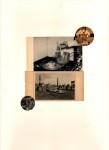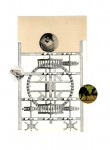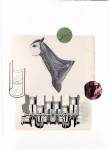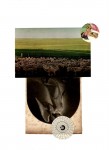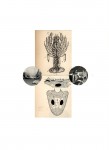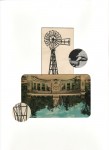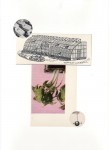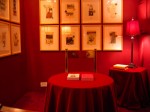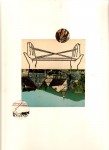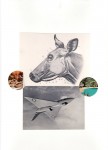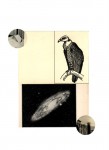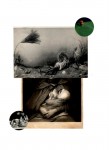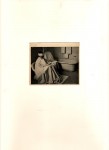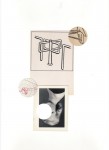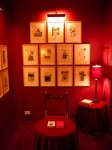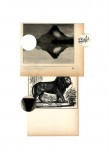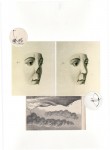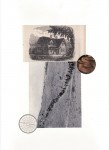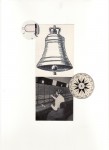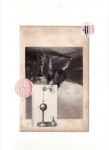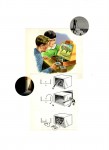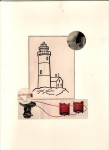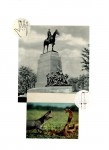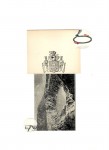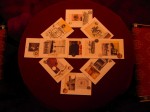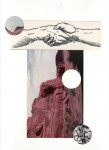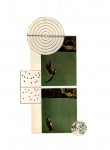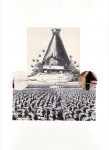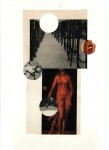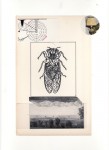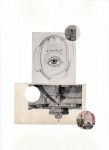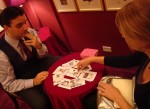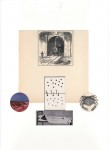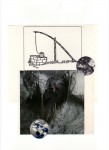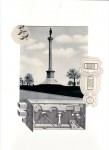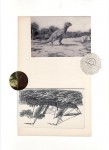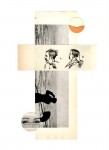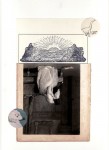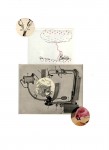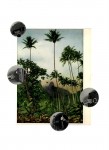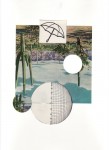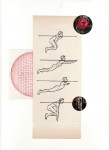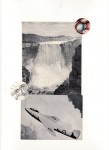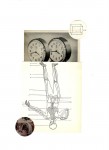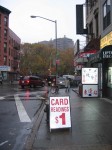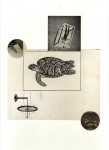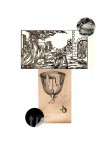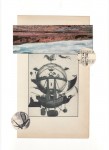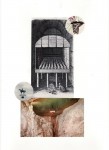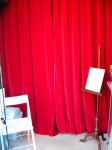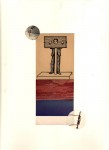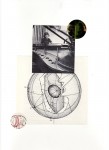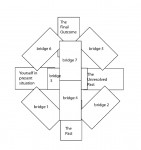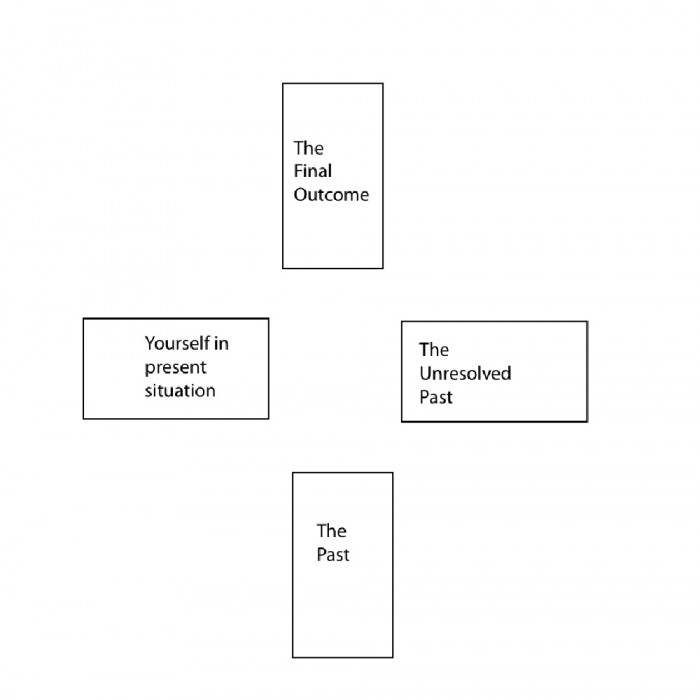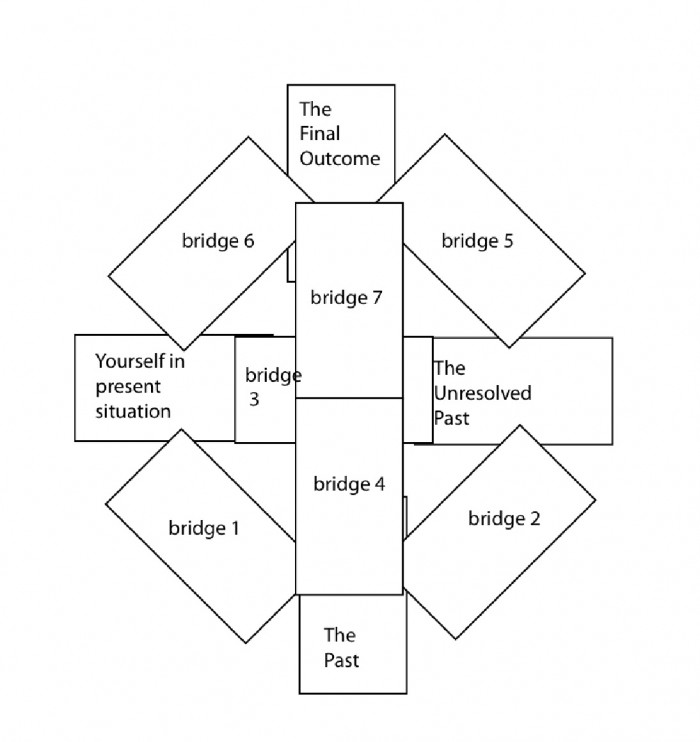The Seven Bridges of Königsberg
The Seven Bridges of Königsberg is a card reading system. 49 memory images hang on the walls of a room. Visitors are invited to choose seven cards with representations of those 49 images and engage in a dialougue regarding about themselves and their present state of mind. No single selection brings the same interpretation, and the system can be used to answer questions and formulate answers, whether of a personal or general nature. This project brings together mechanisms and fields such as narratology, the art of memory, hermeneutics, topology, divination, and symbolic systems of order and chance. The title of the project is taken after a famous mathematical problem from the XVIIIth century that became the foundation of modern graph theory. Using the city of Königsberg as an example, the problem asks to find a walk through the city that would cross each one of its seven bridges only once.
The Seven Bridges of Königsberg was presented in October 2008 in downtown Manhattan as the inaugural exhibition of the alternative space Forever & Today. For a month, the gallery was turned into a card-reading parlor into which street visitors would enter and pay for a card reading.
Visitors were given a text that described the process of the reading of the cards and the history of the problem of the Seven Bridges of Königsberg. (see below)
The Seven Bridges of Königsberg
(An Accompanying Text That Does Not Explain Anything)
NYC
2008
Throughout his eighty years of life, Immanuel Kant never traveled beyond the outskirts of his native Königsberg. His absence of travel experience, which even in his time and for a person of his stature were unusual, and yet for the philosopher this was most decidedly not a reflection of a sedentary spirit. It certainly was never apparent to his students, who usually were impressed by his detailed descriptions of European cities and his erudite knowledge of world affairs. We are also told by De Quincey and Wasianski that Kant also was a constant stroller, and had such a rigorous and precise walking schedule after dinner that his neighbors would adjust their clocks when the philosopher passed by.
Kant placed great importance to periods of silence and reflection. During his entire adult life, and particularly during a period known as his “silent decade” when he wrote The Critique of Pure Reason, the philosopher would spend his evening strolls reflecting upon what he had read earlier in the day. When Kant would return home, he would sit in his study and spend some time reading, and continue his reflections while looking out the window looking at the old tower of Lobenicht.
Kant’s walking path is not described by his biographers, but in late XVIIIth Century Königsberg it would have been hard not to include its various bridges, which join two islands and each other with the mainland. It would also be hard not to imagine that Herr Kant, while crossing them, would not have thought more than once about the famous problem of The Seven Bridges of Königsberg. The problem was to prove on whether it is possible to follow a path that crosses each bridge exactly once and return to the starting point. The solution to the problem was provided during Kant’s youth by the Swiss scientist Leonhard Euler, the preeminent mathematician of the Eighteenth century. Euler, who introduced much of the terminology of modern Mathematics and Physics, proved in 1736 that it was impossible to cross the seven bridges of Königsberg in a continuous path only once. He reformulated the problem in abstract terms, creating a graph that eliminated all features of the problem except the list of landmasses and the bridges connecting them. Next he observed that during any walk in the graph, the number times one enters a non-terminal vertex (or bridge) equals the number of times one leaves it. Since (in this case) at most two landmasses can serve as the endpoints of a putative walk, the existence of a walk traversing each bridge once leads to a contradiction.
Euler’s solution to The Seven Bridges of Königsberg is generally considered as a foundational theorem that led to the birth of Topology and Graph Theory, which is in turn the guiding principle of modern computation. Euler’s thought, in a larger sense, was influential in Kant as he developed a philosophy that countered skeptical empiricism and used logic to arrive to an absolute moral and spiritual laws.
Königsberg suffered three stages of destruction. The first stage took place in 1944, when the British Royal Air Force raided the city. The second stage was an assault of the Soviet Army in April 1945. In 1946 the city was ceded to the Soviet Union and its name was changed to Kaliningrad under the Postdam Agreement. The third period of destruction lasted from 1945 until the 1980s. The ideological task of that period, set by the Soviet government, was the construction of a new Russian city. This task presupposed the deliberate extermination of everything reminiscent of the German/Prussian past. Traits of the old Königsberg recognizable in its ruins ought to have been erased. Blocks of buildings as Kneiphof and Altstadt, the northern part of Vorstadt and southern Lobenicht were demolished almost completely.
The present card system functions around the principle of establishing a topology of the present by laying the foundations of the past, in the form of four figurative “landmasses” that become the primary set of four cards: The Present, the Final Outcome, The Past, and The Unresolved Past. Further, and establishing an Eulerian Circuit of sorts, seven cards are set, as bridges onto the primary cards to establish the interconnections between causes and effects.
THE LAYING OF THE CARDS
The cards are to be laid out following the original structure of the city of Konigsberg.
The first four cards are laid out in a cross format. Each corresponds to a landmass, or, in the symbolism of the cards, to yourself in the present situation faced with the past, the final outcome, and the unresolved past.
Each one of the seven cards that will bridge these four components will be laid down.
The first card to be laid is the one bridging Yourself to the Past. This card helps establish the way in which the past influences your present situation, and the way in which it becomes a positive or detrimental factor in influencing the present situation.
The second card to be laid is the one bridging The Past with The Unresolved Past. This second card helps establish the way in which that which is unresolved came about, and what are the origins of this issue that has not yet been addressed.
The fourth card to be laid bridges The Past with the Third Bridge. This is the second most significant card, as it connects the lower half of your life and your situation, summarizing the nature of the question, the issues of the past, and its relationship to the present.
The fifth card to be laid is the one bridging The Unresolved Past to Yourself. This card helps clarify the situation or reason by which that which remains unresolved may become or is currently an issue to be considered in the present situation. Often this card helps reveal the presence of a person who is important in this situation.
The third card to be laid is the one bridging The Unresolved Past with the Final Outcome. It is the first bridging card that connects to the future, and the one that may lay the foundation to understand in which sense the way in which previous events may link to what is to come.
The sixth card to be laid is the one bridging Yourself in the Present Situation with The Final Outcome.
The seventh and last card is the one bridging the third bridging card with the Final Outcome, providing the last statement of the system.
CARD NOMENCLATURE
- The Lighthouse
This card relates to being a spectator or witness of an event. It connects with the ability to see from far away, perhaps see the future with clarity. The private becomes public. It is a card of revelation. Someone or something that is guiding us. Looking for the comfortable home, comfort food.
- Cat’s Cradle
This is the card of childhood games. Old lessons that we learned in school. This card is often connected to family problems, and also to how we are attracted to those problems as adults. This card represents competitiveness, our place in the ambiguity of being dependent or being independent.
- Pillory
A problem that we don’t seem to be able to solve by ourselves. An embarrassing situation that is made public in front of others. Issues that apparently are simple to others but not to ourselves. Lack of confidence, a labyrinth without a labyrinth, a complex situation that we are not even able to describe or articulate.
- Temple
This card represents our inner sanctuary, our personal memory: the places (periods of time or physical spaces) that are important to us. Damage that has been done to us, to someone or to something that in a way has also been comforting or has brought positive things (the good that has been brought by something bad).
- Consent
This is the connecting card of this deck. It stands for the outer layer of everything. It also stands for veiled vanity: our inability to see makes us very comfortable.
- The Windmill
This is the card for the construction of imaginary places. It is the card of the idealists, and stands for the construction of dreams.
- Marienbad
Déjà vu, that which is repeated. This card stands for the presence of something or someone in our lives but we are not certain that it is there. We think we are being observed, and we feel we are in an unfamiliar place, but at the same time the sense of unfamiliarity is oddly familiar.
- Holiday.
Looking inside to what nourishes us. Those remote places of comfort, those places where we feel very comfortable, places of escape while we know there is war going on elsewhere cow’s milk and all those domestic commodities. A possible danger that is hovering over ourselves. Oblivion. It is a card of denial.
- Actor
There is something that we can’t detect. Don’t lose your face in spite your nose. Follow your instincts. There may be a storm coming up soon and you may not realize it at this moment.
- Station
The light at the end of the tunnel. The end of a sickness. Exchange. Coming out from dark to light. This is a transitional card.
Generally, something very difficult or very bad is ending. But you could also be imagining that things are improving. Slow game.
- Martir
We never know the mechanisms of history. Enigmas that are hard to decipher. There is a story behind of which we will never know the true details. This is the card for the conspiracy theorists. It is the card of the absurd decisions and the message that there are decisions that you can never back track from.
- The Tomb of the Algonquians
Exploring an unknown place. This is the time to analyze your own past, to talk to the elders, or to whoever is the person that has the institutional memory, because there it is where you will find the clues. This is the place where some things are incredibly ephemeral and other stay forever, like death. This is the card of the in between place between the cradle and the mausoleum, between complete ignorance and total knowledge, the card that tells you that both are so close to each other that it is easy to miss them.
- Nursery
A place where things originate. But it is an artificial place, and it is a card for those who feel vulnerable. Things are growing but could die very easily. It is possible to make things flourish if one knows how to nurture them, but one has to be careful and caring. It means that one has the ability to make things work, but that this ability does not come in a spontaneous manner. It is the card of the good student, but not for the ones who are naturally talented.
- Extinction.
Something that is quickly going away or has already left. This is the card that, more than the others, establishes the sense of passing of things. But like in sunsets or breaks of dawn, there is something revelatory in that moment, whether it is a good or bad moment. We will learn a lot of things about ourselves by fleeting things.
- River-bed
This card stands for the denouement of events. Something is going to finish, and that which was not very clear will now be clear in all its mechanisms. It will not finish with a whimper, but with a bang. It is not a positive card, and may describe a situation that has reached a critical point.
- Music Room
This is a card that stands for all that we were taught. It also stands for sensibility and the transformation of something into art. It connects to the memory that music provides, and how it transports us to another time. That which contains time and memory, could be an object or could be a person. Melodic geography, how a place is constructed individually. This is the card for the talented and for the studious. Something is boring, and there is arduous work behind what you are trying to do.
- Cicada
A card relating to a scene or a place where something unresolved happened. The underground again, things we cannot see. A ritual, a periodic occurrence that we may or may not be aware about, but that is connected with our own rhythms. The card points to secret rituals and to the fact that nature is always wiser than us. Things continue whether we are here or not in the world. This is the card for those in need for structure in their lives, and for the selfish- things are larger than what you think they are.
- Turnstile
A card about the notion of rebound and walking in circles. Other people are making you go where you don’t want to go or where you have been already. You are in a vicious cycle. You are in love, or playing a pointless or dangerous game, and in any case you are a little lost, so it is time to reassess your values and your objectives.
- Battle Horse
A card that relates to the notion of figurative blindness. This is the card for those who think are experts but have a hard time questioning themselves. You have a particular talent or knowledge that you know how to exploit, but that also makes you weak or limits you because you cannot look for any other areas of value in your life. It does become a shield, a protective cocoon.
- Beehive
A card that points to being driven by something deceptive or something that may prove to be costly. This is also a card for mirages, for the sense of having been illuminated, but instead having been deceived.
- Umbrella
This card often points to something has come up that in other circumstances would have been very useful, but not now. This is the card for those with bad timing and who feel to be in a lonely situation. However, it is a card that speaks to those in a challenging situation but that have the abilities and the energy to overcome it. It is a card for those undergoing a dry spell and feeling that there is no real escape for the ordeal they are going through.
- Chameleon
Depending on the position of this card, it is about someone’s transformation or the transformation of a situation. It is a card for those who are in flux, and who are highly adaptable to change. It indicates a situation that is highly volatile, where it is equally possible that you may win or lose to a great degree. Normally people cannot appreciate your great adaptability, but that is because you are able to become invisible. It is a card for those who are able to blend in and can respond to their surroundings without being emotionally affected, who stay above the fray but at the same time are able to fit in.
Never seen species.
- Concorde
Something finally has worked out or will be working out, but also this card is about the deals that lead nowhere. You may have made a business decision that has not or will not work out. Be careful about where you go.
- Dinosaur
The card signals the end of something. Something hasn’t been explained, and events have taken place quite quickly, but still the main reason is very evident. There is someone behind this, and likely someone you know.
- Bell
An event or series of events that are coordinated. This is a card for harmony and for announcing positive events, such as a wedding. You may have something positive with you but perhaps you are not announcing it properly to the rest of the world.
- Swimmer
The swimmer is a character that perfects his abilities, but only to do one single thing.
This is the card for expertise, and for experts. The swimmer knows his objective, but at the same time suffers from lack of perspective and has a hard time looking at the big picture. This is a card for independent people.
- Pendulum
Something needs to be measured. You are the measurement of the situation. You are the person whom others depend for their help and expertise, but you feel lost, and sometimes you don’t know who to trust. First children and only children correspond to this card. You are an empiricist, someone who will only try things for oneself.
- Well
Something is hidden within you or within a place that matters to you, and it is your duty to look for it and take it out in order to solve your problems. This is the card that calls for introspection.
- Balloon
“Happiness lies high for us- it is the ultimate goal for man according to Aristotle. It lies high but sometimes like a balloon it descends upon us and we can reach it.” This is the card of the eccentrics and the adventurers, who often engage in wild goose chases and are very self absorbed.
- Home.
This is the card for returns, the card that indicates that it is time to go back to where we came from, for whatever reason. It also indicates the completion of a journey, which usually seems to be the longest section of any trip. At this point we are naked, fragile, and in need of our families and the others.
- Witch-hunt
This is the card for stupidity and ignorance, for rumors and hearsays, of superstition and isolation. It stands for all the things that you were told were true and for all the defects of your education and the place that educated you.
- The Man with the Iron Mask
This is the card for outer shells, for the protective layers that we wear in order to escape or deny a certain reality. The layers give us confidence, but they may also turn us into a monster. It may relate to a condition that we simply can’t control and we have to learn to live with.
- Explorer
An unexpected situation has brought new insights. We have been forced to see something, he value of something or the bad aspects of something.
- The Twin Kings
This is an ambivalent card: it may stand for two simultaneous strengths but also for a dilemma that we are having in our life. We have to choose and we don’t know which one is going to prevail.
- Threshold
This is the card for all those who want to be on the other side or who want to be someone else. There is always something inaccessible to us, and we define ourselves in terms of how much we want to obtain that which is inaccessible to us.
- The Lover
This is the card for the Platonists, those who think that love and art can coexist, that it is possible to find pure goodness. It is also the card that indicates mortality and points to the end of times, or to the fact that something has or must come to an end.
- The Electric Storm
This is the card of the external forces, which becomes particularly significant when it appears in the context of a bridge to the past. It signals those events or circumstances beyond our control that greatly influence our decisions and our current situation.
- Dream Fairy
Depending on the context, this card points to escapism and contradiction on the one hand, or the ability to think large and retain a positive outlook of the situation on the other. It stands for the ideals that we seek to accomplish.
- Lion in Winter
The end of the game, and the wisdom that comes with it, is often the significance of this card. It is a card that points to our inner strengths gained by experience, and our ability to see the world better thanks to it.
- Deus Ex Machina
This card, like #37, often represents someone’s community —whether family, friends, nation, etc. — and the way its history is playing a part in the question being asked.
- Squirrel
This card stands for an action that is currently being made, a project that is being followed-through. It often indicates the need to change the means to an end, and to indicate the importance of foresight.
- Morning
This is a highly psychological card. It often points to the need of exploring one’s childhood obsessions, or revisiting the early circumstances of the issue at hand. On other contexts, the card is about comfort and leisure.
- Martir
This card brings forth that which has been sacrificed in order to obtain a particular benefit, some of which may be of a personal nature. It also points to a misleading incentive, or a false purpose for something that is being made. However, this card also establishes fortitude and determination.
- Keys
This is an important card of the deck. It points to a gravitating force of a particular situation and often reveals the point where the answer to a problem lies. It presents the notion that the answers to a problem lie in the very nature of a particular place or person. It is a revelatory card of travel and new encounters.
- Vulture
This is a powerful card of warning and insight. Paired with The Lover and The Lion in Winter, also points to the end of a situation, to infinite insight, but also to our need to seek protection from something that may threaten us— the loss of a job, the loss of a friend, and other circumstances that may not benefit us.
- Experiment
This is a card that strongly relates us to our dependence to the others and the tension between the way in which we are being seen and the others see us. The questioner in this case should reflect about this tension and the conflicts within it.
- Venus
This is the card of fulfillment and desire. Depending on the context, it may be pointing to a need to acknowledge the way in which an unconscious desire we have may be driving our actions, or perhaps how a selfish act influenced a situation. In some instances the card is about an unresolved relationship.
- Turtle
This card is about gaining perspective of a particularly confusing situation that is taking place at the time. Things may look extremely difficult or confusing at the time, and this card calls for taking the high road pointing that there is always a means to resolve a problem. It is a reassuring card.
- Last Act
A particular situation has arrived to its ultimate consequences. This card is often related to conversations, speeches, arguments and debates that may have influenced us in some way as well as the situation we are inquiring about. It warns us about the way in which what actually happened is not how it will be remembered and establishes the distance between an event and the memory of it.
Tags: Language, Memory, Occult, Sociology, Transpedagogy
